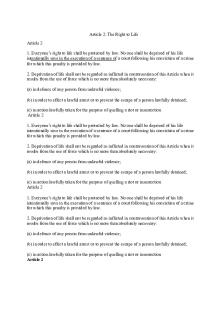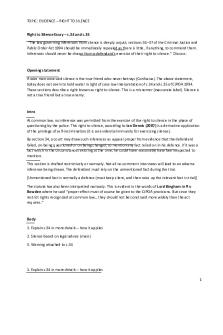Right TO Information PDF

| Title | Right TO Information |
|---|---|
| Course | Public Policy And Administration In India |
| Institution | University of Delhi |
| Pages | 4 |
| File Size | 64.6 KB |
| File Type | |
| Total Downloads | 83 |
| Total Views | 147 |
Summary
RIGHT TO INFORMATION Accountability is defined as the state of being liable or answerable. To be accountable means to be obliged to report, explain or justify something. It means that something is carried out as expected. It is an essential feature of democratic governments. In administrative parlan...
Description
RIGHT TO INFORMATION Accountability is defined as the state of being liable or answerable. To be accountable means to be obliged to report, explain or justify something. It means that something is carried out as expected. It is an essential feature of democratic governments. In administrative parlance, it refers to the liability of government servants to give a satisfactory account of the use of official power to people. This is considered as an effective safeguard against the misuse of power and abuse of public authority. Citizen’s right to information is a necessary condition to achieve an accountable, transparent and participatory government. It empowers people in relation to the state and enhances their control over political resources. It has been seen as the key to strengthening participatory democracy and ushering in people-centred governance, as access to information can empower citizens to demand and get information about public services and actions, thereby leading to welfare. Transparency in government organisations enables them to function more objectively and predictably, simultaneously building trust between citizens and the state. Today several countries are adopting laws that facilitate citizen’s access to information. People want to know how governments function and use public resources. In recognition of the need for transparency in public affairs, the Indian parliament enacted the Right to Information Act on 11 may 2005. However, the history of RTI is a history of struggle between the powers of state, civil society including the media. The road to it culmination has not been a cakewalk. This thus needs special mention. RIGHT TO INFORMATION CAMPAIGN IN INDIA The MAZDOOR KISAN SHAKTI SANGATHAN (MKSS) spearheaded the movement on Right to Information in India. It waged a campaign to secure the right of ordinary people to gain access to information held by government officials. It began as a demand for effective implementation of the Minimum Wages Act and required access to public records to verify work measurements and wage payment. In the due course of their struggle, it became absolutely clear, that the right to information was a part of one’s fundamental right to life and liberty. It was needed to obtain basic living wage, entitlements under the PDS, the medicines the poor ought to receive in public health centres and for contending with coercive abuse by the police. This movement caught the imagination of several activists, civil servants, lawyers and the media, gradually culminating into a National Campaign for People’s Right to Information.
It made effective use of an innovative method called “JAN SUNWAI” or a public hearing, i.e. a gathering of citizens before whom public accounts are read. The MKSS organised several Jan Sunwais, each pointing out discrepancies between official records and reality, exposing cases of fudged muster rolls, overbilled purchases, underpayment of wages and so on. Although not completely successful, these hearings did touch a social chord. The willingness of people to testify at Jan Sunwais was remarkable. It gave them confidence to demand information thereby highlighting the link between information and survival. This also marked the beginning of the concept of social audit in India. Inspired by MKSS, a Delhi-based organisation called Parivartan began similar public hearings. Its task was made conveniently easy by the work done by MKSS. It also led to the development of MOHALLA SAMITIS or local area committees, to monitor the execution of civil works in their respective areas. A major outcome of this campaign was that it shifted the focus from media’s freedom of access to information to citizen’s right to information. Second, it rooted the RTI debate within the constitutionally guaranteed right to life and liberty, highlighting its nature for the realisation of other rights. It brought out the linkage between information and livelihoods, hence survival. In fact, the success of NREGA, which recognises employment as a human right is seen inextricably linked to the effective operationalising of RTI. Third, it looks upon information as a public good, generated for the public by their money. Finally, civil society also perceived it as a tool for greater citizen participation in governance. Along with transparency and governance, this is a key component of democracy. THE RIGHT TO INFORMATION ACT, 2005 The act provides for the proactive disclosure of information, establishment of the Information Commission, appointment of Public Information Officers, procedures for getting information and so on. It gives citizens the right to request access to information held by government at different levels and places a corresponding duty on the government to respond accordingly. “Information” is defined broadly to include print and electronic media as well as physical samples of work. In terms of scope it covers whole of India (except J&K). It lays down the time limit as 30 days for normal applications and 40 where a third party submission is to be called for. These time limits however, are reduced to 48 hours where information sought concerns the life and liberty of a person. The application fee is rupees 10 and no fee is charged from people
below poverty line. The appointment of PIOs is mandatory at every level of the government. Every PIO can be penalised Rs 250 per day, up to a maximum of Rs 25000, for not accepting application, delaying it or providing incomplete and misleading information. Information must be sought in written, through e-mails etc. to the PIO. Application can be rejected only in writing with appropriate reason. The act also defines 10 categories of information that are exempted from disclosure because of their sensitive nature. Information pertaining to intelligence agencies, RAW, IB or frontier forces like the ITBP, BSF, etc. are exempted from the purview of RTI. It provides for the establishment of an Information Commission at the centre and in all states comprising Chief Information Commissioner, appointed by a committee consisting the PM, leader of opposition and a union minister nominated by the PM, and 10 Information Commissioners. CHALLENGES TO EFFECTIVE IMPLEMENTATION Effective implementation of the Act requires a comprehensive analysis of its shortcomings. 1. One major shortfall is lack of clear interpretative guidelines. Disagreement between civil society and government about some of its provisions. 2. Reform of cumbersome administrative procedure and discretionary powers of the bureaucracy. 3. Lack of basis infrastructural and financial support in implementation. 4. Poor records management and obsolete information retrieval systems hamper effective implementation. The utility of e-governance becomes important here. 5. Inconsistent implementation of the act by government departments at different levels is another major challenge. State governments have the discretion to issue rules under the act on fees and other administrative procedures. Lack of consistency in fee structure and the exorbitant fees levied in states like Tamil Nadu, Orissa etc. is becoming a major disincentive for people to seek the use of RTI. 6. Delay in implementation, especially appointment of PIOs to various levels of the government and set up of Information Commissions. 7. Government officials have also been found ill-informed about their roles and responsibilities under the act. Need for investment in training programs by central and state governments. 8. Culture of secrecy in bureaucratic organisations.
CONCLUSION The right to information movement in India is unique throughout the developed and developing world. It is one of the few campaigns which, by linking RTO to livelihood and survival, made it a people-centred movement. It has powerfully been linked with access to other basic rights such as food and work that had once been an esoteric, elitist concept. The success of NREGA has also been linked to its successful incorporation of RTI into its fold. To be effective, it needs to be holistically integrated into other government policies and programs to ensure that the accountability and transparency are built into the overall functioning of the bureaucracy at every level....
Similar Free PDFs

Right TO Information
- 4 Pages

Right to information
- 5 Pages

Right to infomration notes
- 77 Pages

Right to Support
- 5 Pages

Right to an Occupation Fee
- 1 Pages

Problem Question Right to Cancel
- 11 Pages

Article 2 Right to Life
- 8 Pages

Access to Information
- 4 Pages

Art 5 ECHR Right to Liberty
- 6 Pages
Popular Institutions
- Tinajero National High School - Annex
- Politeknik Caltex Riau
- Yokohama City University
- SGT University
- University of Al-Qadisiyah
- Divine Word College of Vigan
- Techniek College Rotterdam
- Universidade de Santiago
- Universiti Teknologi MARA Cawangan Johor Kampus Pasir Gudang
- Poltekkes Kemenkes Yogyakarta
- Baguio City National High School
- Colegio san marcos
- preparatoria uno
- Centro de Bachillerato Tecnológico Industrial y de Servicios No. 107
- Dalian Maritime University
- Quang Trung Secondary School
- Colegio Tecnológico en Informática
- Corporación Regional de Educación Superior
- Grupo CEDVA
- Dar Al Uloom University
- Centro de Estudios Preuniversitarios de la Universidad Nacional de Ingeniería
- 上智大学
- Aakash International School, Nuna Majara
- San Felipe Neri Catholic School
- Kang Chiao International School - New Taipei City
- Misamis Occidental National High School
- Institución Educativa Escuela Normal Juan Ladrilleros
- Kolehiyo ng Pantukan
- Batanes State College
- Instituto Continental
- Sekolah Menengah Kejuruan Kesehatan Kaltara (Tarakan)
- Colegio de La Inmaculada Concepcion - Cebu






